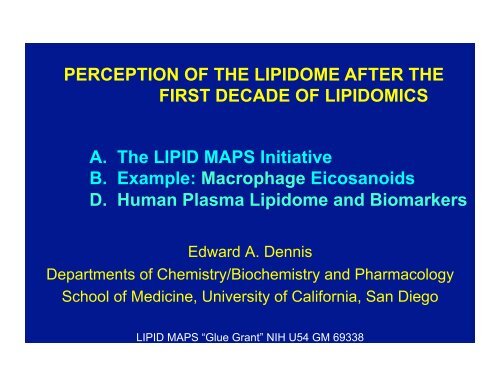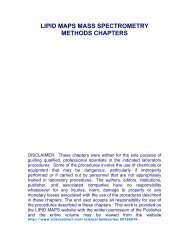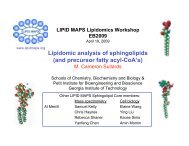Our perception of the lipidome after the first decade of ... - Lipid Maps
Our perception of the lipidome after the first decade of ... - Lipid Maps
Our perception of the lipidome after the first decade of ... - Lipid Maps
You also want an ePaper? Increase the reach of your titles
YUMPU automatically turns print PDFs into web optimized ePapers that Google loves.
PERCEPTION OF THE LIPIDOME AFTER THE<br />
FIRST DECADE OF LIPIDOMICS<br />
A. The LIPID MAPS Initiative<br />
B. Example: Macrophage Eicosanoids<br />
D. Human Plasma <strong>Lipid</strong>ome and Biomarkers<br />
Edward A. Dennis<br />
Departments <strong>of</strong> Chemistry/Biochemistry and Pharmacology<br />
School <strong>of</strong> Medicine, University <strong>of</strong> California, San Diego<br />
LIPID MAPS “Glue Grant” NIH U54 GM 69338
4 base side chains<br />
20 amino acid side chains<br />
<strong>Lipid</strong>omics Joins<br />
<strong>the</strong> Omics Evolution<br />
(2009), Dennis,<br />
PNAS, 106, 2089.<br />
nucleic acids, amino acids,<br />
sugars and fats: >10 5 <br />
all <strong>the</strong> fats: >10 5
Increase in Omics Citations 1985-2009<br />
Number <strong>of</strong> Citations<br />
Wenk MR (2010) <strong>Lipid</strong>omics:<br />
New Tools and Applications.<br />
Cell, 143, 888-895.<br />
Year
<strong>Lipid</strong>omics Publications 2002-2013<br />
<strong>Lipid</strong>omics publications<br />
LIPID MAPS publications<br />
Publications<br />
Publications<br />
Year<br />
Year
_____________ _______________<br />
LIPID MAPS<br />
TM<br />
TM<br />
Saccharolipids / Polyketides
“CLASS”: Comprehensive<br />
<strong>Lipid</strong>omics Analysis using<br />
Separation Simplification<br />
a “divide-and-conquer” strategy<br />
category specific<br />
(deuterated, odd-chain carbon)<br />
category optimized<br />
(liq-liq, SPE)<br />
cells<br />
tissues<br />
sonicate<br />
homogenate<br />
cells or tissues<br />
probe<br />
internal standards<br />
extraction<br />
extract<br />
medium<br />
category specific<br />
(GC, NP-HPLC, RP-HPLC, chiral, specialty)<br />
GC<br />
LC<br />
Harkewicz & Dennis, “Applications <strong>of</strong> mass<br />
spectrometry to lipids and membranes”<br />
Ann Rev Biochem, 80: 301-325 (2011)<br />
mass spectrometer<br />
(variables)<br />
1. Mass spectrometer types<br />
2. Ionization mode<br />
3. Additives (for ionization)<br />
4. Mass spectrometer monitoring modes
Kdo 2 -<strong>Lipid</strong> A (KLA, LPS subspecies)<br />
A specific agonist <strong>of</strong> TLR-4 on RAW 264.7 macrophages<br />
Raetz et al., 2006, J. <strong>Lipid</strong> Res. 47: 1097<br />
Nuclei – DAPI<br />
Mitochondria – MitoTracker Red<br />
O-Specific<br />
chain<br />
Polysaccharide<br />
Core<br />
Kdo<br />
<strong>Lipid</strong> A<br />
Glycophospholipid
Dennis et al (2010)<br />
J. Biol. Chem, 51, 39976-85
Cellular Eicosanoid Metabolism<br />
Buczynski, Dumlao, Dennis (2009) JLR, 50, 1015-38
COX<br />
Cellular eicosanoid metabolism<br />
CYP(ω)<br />
5-LOX<br />
CYP(EET)<br />
Buczynski, Dumlao, Dennis, 2009, JLR, 50: 1015-38<br />
12-LOX<br />
15-LOX
COX<br />
Cellular eicosanoid metabolism
Directed Proteomics on Enzymes <strong>of</strong><br />
Eicosanoid Biosyn<strong>the</strong>sis<br />
2<br />
8)(#<br />
8)($<br />
1,6/-<br />
7!1)<br />
+,&0<br />
3',)<br />
+3$*,)&#)(41(<br />
!),)5$#1!<br />
+),-.)"*<br />
)3$(#<br />
)6$(<br />
)+$(<br />
)1*62<br />
*)(00<br />
)3$($<br />
)3$(0<br />
!"!#$$%"&'()*'<br />
+),-.)"<br />
)3$(5<br />
)8$(<br />
-'."#<br />
-'."$<br />
-'."5<br />
)1*($<br />
)1*(#<br />
))-(+<br />
))-(-<br />
))-(*<br />
,;32<br />
1-$(<br />
+)3)#<br />
+)3)$<br />
'!1($<br />
1,-2<br />
**1#<br />
)1*+2<br />
)1*+$<br />
!1'02<br />
**1% 9*215<br />
'!1(#<br />
-$(21#<br />
!10(#<br />
'&(#<br />
'-.45<br />
!10($<br />
!/,-0<br />
)1*32<br />
)*32$<br />
13&)<br />
!."%<br />
)*,#<br />
)*,$<br />
-!%-)<br />
/0#1+$%"&'()*'<br />
+),-.)"<br />
-CDEFGHIJGE<br />
-EGH<br />
!"#$&<br />
!."#$<br />
!."35<br />
!"#$3<br />
-,(<br />
670#1+$%"&'()*'<br />
+),-.)"<br />
!"#$!<br />
!"#%&<br />
')$5:<br />
)-$*%<br />
)-$*-<br />
)-$*"<br />
'&(#<br />
)*+,<br />
')#&#<br />
')$%0<br />
=>638:<br />
')$5<br />
')$@%<br />
')0--<br />
')085<br />
')$54<br />
')0-3<br />
6/0#1+$%"&'()*'<br />
+),-.)"<br />
')083<br />
')$%%<br />
&
Eicosanoid Genes to Proteins to Metabolites<br />
Proteins<br />
Quehenberger & Dennis, New Eng. J. Medicine, 365, 1812-23 (2011)
The Beneficial <strong>Lipid</strong>s in Fish Oil<br />
• Fish oil is composed primarily <strong>of</strong> two ω-‐3 PUFAs: <br />
ω-‐3 <br />
ω <br />
Eicosapentaenoic Acid (EPA) <br />
(C20:5, ω-‐3) <br />
ω-‐3 <br />
Docosahexaenoic Acid (DHA) <br />
(C22:6, ω-‐3) <br />
• Humans syn<strong>the</strong>size from essen=al fa>y acid α-‐linolenic acid (C18:3, ω-‐3) <br />
ω <br />
• EPA is found at barely detectable levels in humans <br />
• DHA is more abundant than EPA; found primarily in <strong>the</strong> brain and re=na
Arachidonic Acid Serves as a<br />
Precursor for Many Eicosanoids<br />
<br />
<br />
EPA/DHA<br />
<br />
<br />
<br />
Are eicosanoids less pro-inflammatory when derived from EPA/DHA
Effects <strong>of</strong> PUFA Supplementation on ATP<br />
Stimulated COX-1 and 5-LOX Signaling<br />
Norris & Dennis, PNAS (2012) 109, 8517
Omega-3 Implications for Nutrition<br />
• The global effects <strong>of</strong> EPA and DHA on normal lipid<br />
metabolism can be quantitatively studied.<br />
• EPA and DHA affect <strong>the</strong> overall eicosadome decreasing<br />
production <strong>of</strong> some, but not all, AA-derived eicosanoids.<br />
• There is a concomitant increase in specific EPA- and<br />
DHA-derived metabolites.<br />
• Deciphering <strong>the</strong> role <strong>of</strong> fish oil-derived ω-3 EPA and DHA<br />
in inflammatory eicosanoid signaling provides insight as<br />
to <strong>the</strong>ir role as <strong>the</strong>rapeutic/nutritional agents.<br />
Norris & Dennis, PNAS (2012) 109, 8517
NIST collected (pooled) fasting plasma from 100 individuals<br />
50% female and 50% male; age 40-50<br />
15% <strong>of</strong> <strong>the</strong> total taken from<br />
individuals <strong>of</strong> Hispanic origin!
Human Plasma Metabolites (mg/dL)<br />
Nucleic Acids<br />
<strong>Lipid</strong>s<br />
Amino Acids<br />
Sugars
Human Plasma <strong>Lipid</strong> Categories (µM)<br />
Sterol <strong>Lipid</strong>s<br />
Sphingolipids<br />
Fatty Acyls<br />
Glycerolipids<br />
Glycerophospholipids<br />
Prenols
Human Plasma <strong>Lipid</strong> Diversity<br />
J <strong>Lipid</strong> Res, 51, 3299-3305 (2010)
Plasma <strong>Lipid</strong>s in <strong>the</strong> Metabolic Syndrome<br />
Quehenberger & Dennis, New Eng. J. Medicine, 365, 1812-23 (2011)
Charles Brown<br />
Univ. <strong>of</strong> Missouri<br />
George Kokotos<br />
Univ. <strong>of</strong> A<strong>the</strong>ns<br />
Kang Zhang<br />
Varnavas Mouchlis Matt Buczynski John Burke Yasu Kihara<br />
Tony Yaksh<br />
Virgil Woods<br />
Eduard Sabidó<br />
Ruedi Aebersold<br />
Alex Andreyev Howard Hsu Oswald Quehenberger Paul Norris<br />
Chris Glass<br />
Eoin Fahy<br />
S. Subramaniam<br />
Andy McCammon<br />
Darren Dumlao Ann Gregus Jian Cao Aaron Armando Ishita Shah
The LIPID MAPS Consortium<br />
L-R: C.R.H. Raetz, J.L. Witztum, N. Winograd, A.H. Merrill, R.C. Murphy, M.S. VanNieuwenhze,<br />
E.A. Dennis, D.W. Russell, W.A. Shaw, C.K. Glass, J. Chin (NIH), S. Subramaniam, H.A. Brown





